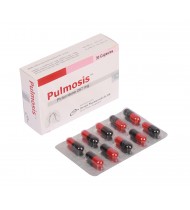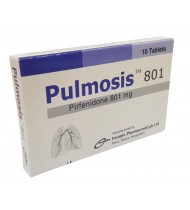Pirfenidone
Indications
Pharmacology
Dosage & Administration
- Days 1 to 7: One 267 mg tablet administered three times a day (801 mg/day)
- Days 8 to 14: One 534 mg tablets administered three times a day (1602 mg/day)
- Day 15 onward: Three 267 mg tablets or one 801 mg tablet administered three times a day (2403 mg/day)
Dose adjustments and other considerations for safe use: Gastrointestinal events: In patients who experience intolerance to therapy due to gastrointestinal side effects, patients should be reminded to take the medicinal product with food. If symptoms persist Pirfenidone may be reduced to 1-2 capsules (267 mg-534 mg) 2-3 times/day with food with re-escalation to the recommended daily dose as tolerated. If symptoms continue, patients may be instructed to interrupt treatment for 1 to 2 weeks to allow symptoms to resolve.
Photosensitivity reaction or rash: Patients who experience a mild to moderate photosensitivity reaction or rash should be reminded of the instruction to use a sunblock daily and to avoid sun exposure. The dose of Pirfenidone may be reduced to 3 capsules/day (1 capsule three times a day). If the rash persists after 7 days, Pirfenidone should be discontinued for 15 days, with re-escalation to the recommended daily dose in the same manner as the dose escalation period. Patients who experience severe photosensitivity reaction or rash should be instructed to interrupt the dose and to seek medical advice. Once the rash has resolved, Pirfenidone may be re-introduced and re-escalated up to the recommended daily dose at the discretion of the physician.
Hepatic function: In the event of significant elevation of alanine and/or aspartate aminotransferases (ALT/AST) with or without bilirubin elevation, the dose of Pirfenidone should be adjusted or treatment discontinued according to the guidelines.
Contraindications
Hepatic function: Elevations in ALT and AST >3 × upper limit of normal (ULN) have been reported in patients receiving therapy with Pirfenidone. Rarely these have been associated with concomitant elevations in total serum bilirubin. Liver function tests (ALT, AST and bilirubin) should be conducted prior to the initiation of treatment with Pirfenidone, and subsequently at monthly intervals for the first 6 months and then every 3 months thereafter. In the event of significant elevation of liver aminotransferases the dose of Pirfenidone should be adjusted or treatment discontinued according to the guidelines listed below. For patients with confirmed elevations in ALT, AST or bilirubin during treatment, the following dose adjustments may be necessary.
Recommendations in case of ALT/AST elevations: If a patient exhibits an aminotransferase elevation to >3 to ≤5 X ULN after starting Pirfenidone therapy, confounding medicinal products should be discontinued, other causes excluded, and the patient monitored closely. If clinically appropriate the dose of Pirfenidone should be reduced or interrupted. Once liver function tests are within normal limits Pirfenidone may be re-escalated to the recommended daily dose if tolerated. If a patient exhibits an aminotransferase elevation to >5 X ULN accompanied by symptoms or hyperbilirubinaemia, Pirfenidone should be discontinued and the patient should not be rechallenged. If a patient exhibits an aminotransferase elevation to >5 X ULN, Pirfenidone should be discontinued and the patient should not be rechallenged.
Hepatic impairment: In subjects with moderate hepatic impairment (i.e. Child-Pugh Class B), Pirfenidone exposure was increased by 60%. Pirfenidone should be used with caution in patients with pre-existing mild to moderate hepatic impairment (i.e. Child-Pugh Class A and B) given the potential for increased Pirfenidone exposure. Patients should be monitored closely for signs of toxicity especially if they are concomitantly taking a known CYP1A2 inhibitor. Pirfenidone has not been studied in individuals with severe hepatic impairment and Pirfenidone should not be used in patients with severe hepatic impairment.
Photosensitivity reaction and rash: Exposure to direct sunlight (including sunlamps) should be avoided or minimised during treatment with Pirfenidone. Patients should be instructed to use a sunblock daily, to wear clothing that protects against sun exposure, and to avoid other medicinal products known to cause photosensitivity. Patients should be instructed to report symptoms of photosensitivity reaction or rash to their physician. Severe photosensitivity reactions are uncommon. Dose adjustments or temporary treatment discontinuation may be necessary in mild to severe cases of photosensitivity reaction or rash.
Dizziness: Dizziness has been reported in patients taking Pirfenidone. Therefore, patients should know how they react to this medicinal product before they engage in activities requiring mental alertness or coordination. In clinical studies, most patients who experienced dizziness had a single event, and most events resolved, with a median duration of 22 days. If dizziness does not improve or if it worsens in severity, dose adjustment or even discontinuation of Pirfenidone may be warranted.
Fatigue: Fatigue has been reported in patients taking Pirfenidone. Therefore, patients should know how they react to this medicinal product before they engage in activities requiring mental alertness or coordination.
Weight loss: Weight loss has been reported in patients treated with Pirfenidone. Physicians should monitor patients’ weight, and when appropriate encourage increased caloric intake if weight loss is considered to be of clinical significance. Interactions with other medicinal products and other forms of interaction. Approximately 70-80% of pirfenidone is metabolised via CYP1A2 with minor contributions from other CYP isoenzymes including CYP2C9, 2C19, 2D6 and 2E1. Consumption of grapefruit juice is associated with inhibition of CYP1A2 and should be avoided during treatment with pirfenidone.
Fluvoxamine and inhibitors of CYP1A2: In a Phase 1 study, the co-administration of Pirfenidone and fluvoxamine (a strong inhibitor of CYP1A2 with inhibitory effects on other CYP isoenzymes [CYP2C9, 2C19, and 2D6]) resulted in a 4-fold increase in exposure to pirfenidone in non-smokers. Pirfenidone is contraindicated in patients with concomitant use of fluvoxamine. Fluvoxamine should be discontinued prior to the initiation of Pirfenidone therapy and avoided during Pirfenidone therapy due to the reduced clearance of pirfenidone. Other therapies that are inhibitors of both CYP1A2 and one or more other CYP isoenzymes involved in the metabolism of pirfenidone (e.g. CYP2C9, 2C19, and 2D6) should be avoided during pirfenidone treatment. In vitro in vivo extrapolations indicate that strong and selective inhibitors of CYP1A2 (e.g. enoxacin) have the potential to increase the exposure to pirfenidone by approximately 2 to 4-fold. If concomitant use of Pirfenidone with a strong and selective inhibitor of CYP1A2 cannot be avoided, the dose of Pirfenidone should be reduced to 801 mg daily (one capsule, three times a day). Patients should be closely monitored for emergence of adverse reactions associated with Pirfenidone therapy. Discontinue Pirfenidone if necessary.
Co-administration of Pirfenidone and 750 mg of ciprofloxacin (a moderate inhibitor of CYP1A2) increased the exposure to pirfenidone by 81%. If ciprofloxacin at the dose of 750 mg twice daily cannot be avoided, the dose of Pirfenidone should be reduced to 1602 mg daily (two capsules, three times a day). Pirfenidone should be used with caution when ciprofloxacin is used at a dose of 250 mg or 500 mg once or twice daily. Pirfenidone should be used with caution in patients treated with other moderate inhibitors of CYP1A2 (e.g. amiodarone, propafenone). Special care should also be exercised if CYP1A2 inhibitors are being used concomitantly with potent inhibitors of one or more other CYP isoenzymes involved in the metabolism of pirfenidone such as CYP2C9 (e.g. amiodarone, fluconazole), 2C19 (e.g. chloramphenicol) and 2D6 (e.g. fluoxetine, paroxetine).
Cigarette smoking and inducers of CYP1A2: A Phase 1 interaction study evaluated the effect of cigarette smoking (CYP1A2 inducer) on the pharmacokinetics of Pirfenidone. The exposure to pirfenidone in smokers was 50% of that observed in non-smokers. Smoking has the potential to induce hepatic enzyme production and thus increase medicinal product clearance and decrease exposure. Concomitant use of strong inducers of CYP1A2 including smoking should be avoided during Pirfenidone therapy based on the observed relationship between cigarette smoking and its potential to induce CYP1A2. Patients should be encouraged to discontinue use of strong inducers of CYP1A2 and to stop smoking before and during treatment with pirfenidone. In the case of moderate inducers of CYP1A2 (e.g. omeprazole), concomitant use may theoretically result in a lowering of pirfenidone plasma levels. Co-administration of medicinal products that act as potent inducers of both CYP1A2 and the other CYP isoenzymes involved in the metabolism of pirfenidone (e.g. rifampicin) may result in significant lowering of pirfenidone plasma levels. These medicinal products should be avoided whenever possible.
Side Effects
Pregnancy & Lactation
Lactation: It is unknown whether pirfenidone or its metabolites are excreted in human milk. Available pharmacokinetic data in animals have shown excretion of pirfenidone and/or its metabolites in milk with the potential for accumulation of pirfenidone and/or its metabolites in milk. A risk to the suckling child cannot be excluded. A decision must be made whether to discontinue breast-feeding or to discontinue from Pirfenidone therapy, taking into account the benefit of breast-feeding for the child and the benefit of Pirfenidone therapy for the mother.
Fertility: No adverse effects on fertility were observed in preclinical studies. Effects on ability to drive and use machines: No studies on the effects of the ability to drive and use machines have been performed. Pirfenidone may cause dizziness and fatigue, which could influence the ability to drive or use machines.
Overdose Effects
Therapeutic Class
Storage Conditions
Pulfibro Tablet 267 mg
IndicationsPirfenidone is indicated in adults for the treatment of mild to moderate Idiopathic Pulmo..
45.00Tk.
Pulfibro Tablet 534 mg
IndicationsPirfenidone is indicated in adults for the treatment of mild to moderate Idiopathic Pulmo..
80.00Tk.
Pulfibro Tablet 801 mg
IndicationsPirfenidone is indicated in adults for the treatment of mild to moderate Idiopathic Pulmo..
125.00Tk.
Pulmosis Capsule 267 mg
IndicationsPirfenidone is indicated in adults for the treatment of mild to moderate Idiopathic Pulmo..
45.00Tk.
Pulmosis Capsule 801 mg
IndicationsPirfenidone is indicated in adults for the treatment of mild to moderate Idiopathic Pulmo..
125.00Tk.



